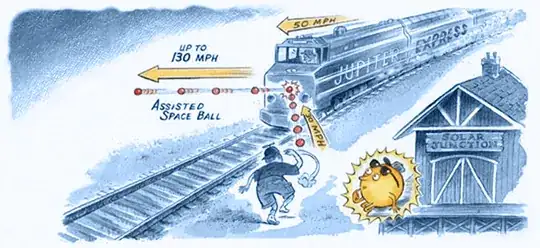It seems impossible, yet I'm thinking that maybe because the ball compresses against the bat a bit it acts a little like a spring, and DOES travel faster than the bat?
EDIT: This is just a clarification, and not really part of the question, but I think it may be valuable. For people saying momentum is conserved, I'm not sure what you are imagining, but take a moment to think about the equation you keep on mentioning: $$M_\textrm{bat}V_\textrm{bat} = M_\textrm{ball}V_\textrm{ball}$$ This is saying that the bat somehow transfers ALL of its momentum to the ball.
The only way this can ever happen is if the bat comes to a dead stop when it hits the ball, somehow holds it in place while transferring ALL of its momentum to it (that phrase doesn't even make logical sense), and then the ball flies off at a much larger velocity.
WERE the bat floating through space and struck a ball, the bat would not stop when it hits the ball, and there is no way it makes sense for the ball to go off at THAT much of a larger velocity. Just imagine a spaceship very slowly drifting through space, and an astronaut who suddenly touches it. Conservation of momentum DOES NOT mean $$M_\textrm{ship}V_\textrm{ship} = M_\textrm{astronaut}V_\textrm{astronaut}$$
According to that, the astronaut would shoot off at hundreds (maybe thousands) of kilometers per hour when being touched by a massive spaceship, and the spaceship would come to a stop, but obviously that doesn't happen. TOTAL momentum is conserved, so that $$M_\textrm{ship1}V_\textrm{ship1} + M_\textrm{astronaut1}V_\textrm{astronaut1} = M_\textrm{ship2}V_\textrm{ship2} + M_\textrm{astronaut2}V_\textrm{astronaut2}$$
but even THAT equation doesn't even apply in the case of the baseball strike since there is a human being providing a force EVEN as the bat hits the ball.
I know this is ingrained deeply in the minds of physics students because we have conservation of momentum drilled into our heads as young students in introductory physics, but I encourage everyone to always think intuitively about physics scenarios before applying equations.
Anyways, I hope that was valuable. Cheers!
